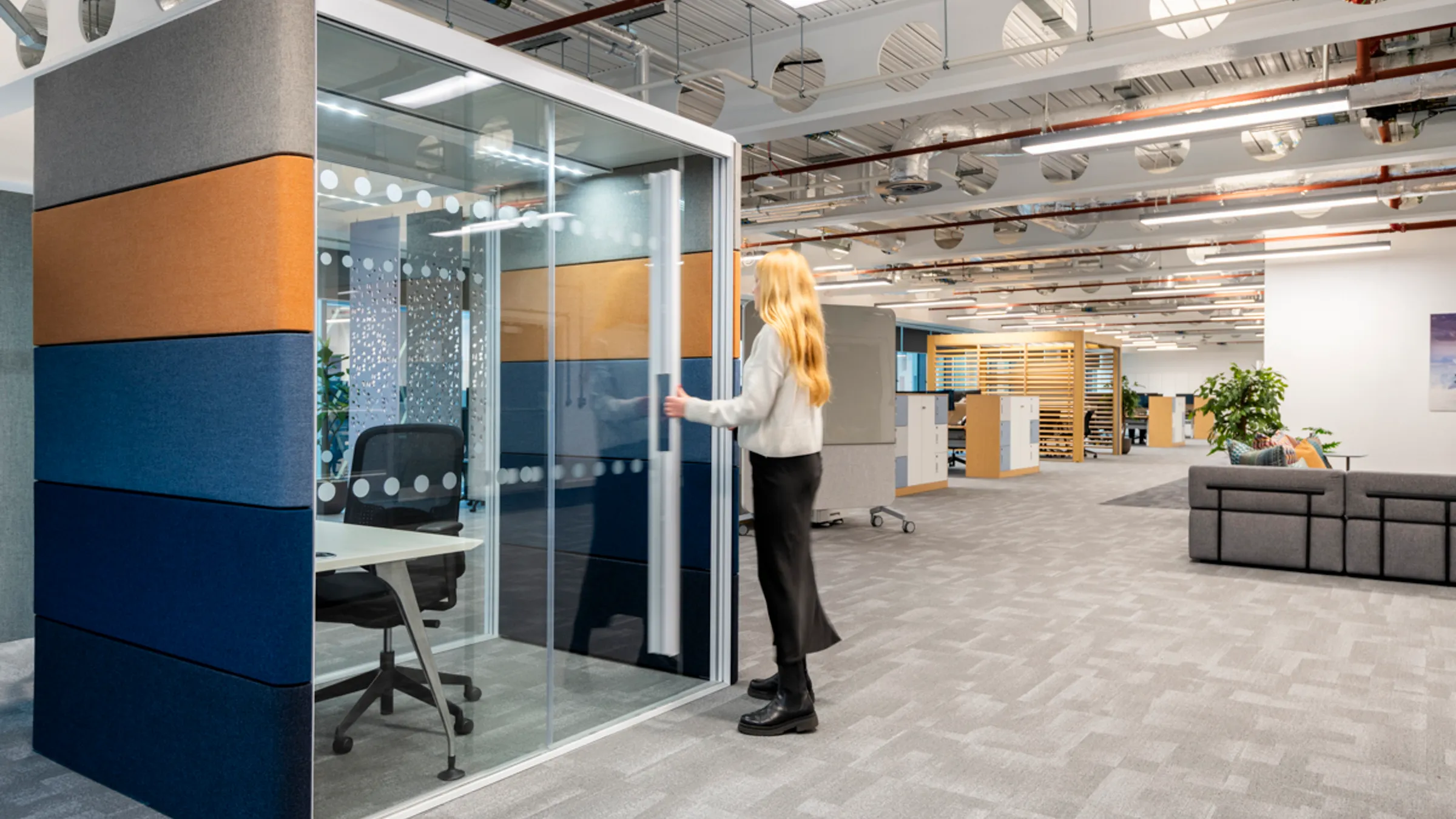Sustainable Choices in Workplace Furniture
How do we make measured decisions in furniture consultancy that support and fulfil sustainability initiatives?


Written by
Fritha Selwyn-Jones
Contents
As brands strive to reduce their environmental impact, one opportunity might be overlooked: the workplace. Minor choices in workplace design, like energy-conserving furnishing options and long-lasting materials, lead to significant and consistently positive passive impacts throughout day-to-day operations.
Sustainability is one of the essential cornerstones of workplace design, and it’s our responsibility as furniture consultants to provide the most effective solutions that support environmental stewardship. Read this article to understand the eco-friendly furnishing choices we make that support our and our clients’ sustainability values.
The Rise of Eco-friendly Materials
When designing for sustainability, we need to consider the characteristics of the materials we use. How can we reduce environmental impact through materials? Selecting recycled materials, seeking out long warranties, avoiding harmful components, and choosing local manufacturers and suppliers all have a positive impact on the carbon footprint of our furnishing choices.
Popular Sustainable Materials
The natural world is miraculous, and combined with innovations in environmentally considerate material production, we have access to some incredible green furniture materials that are strong, durable, aesthetically pleasing, and highly sustainable. Identifying these materials is the first step in sustainable workplace furnishing.
Material | Characteristics | Use in Workplace Furnishing |
Wood | FSC and PEFC-certified pine, oak, and beech | Workstations, chair bases |
Bamboo | Fast-growing, reduces carbon footprint | Modular shelving, desks, storage items |
Natural Fabrics | Wool, hemp, and linen | Upholstery, acoustic panels |
Steel and Aluminum | Strong, recyclable materials | Chair bases, desk frames |
Recycled Materials | Various entire items or components of items | Chairs, tables, storage units, soft furnishings |
Why do these sustainable materials make good choices for furniture manufacture?
Bamboo can grow up to 91cm within 24 hours, making it one of the fastest-growing plants in the world and excellent for high-volume furniture production.
Bamboo absorbs five times more carbon dioxide than the equivalent volume in trees and releases 35% more oxygen, making it excellent for carbon sequestration.
Harvesting bamboo does not kill the plant when done correctly, meaning it can remain in a continuous cycle of growth and harvesting.
One cubic metre of wood can store roughly one tonne of CO2 making wood furniture an excellent carbon sink—meaning it’s capable of storing carbon absorbed during the growth of the source trees.
Over 90% of end-of-life steel is recycled making it one of the most recyclable materials. It can be recycled infinitely without losing its properties.
When recycled, steel saves up to 74% of the energy otherwise required to produce new steel from raw materials.
Roughly 75% of all aluminium ever produced is still in use today due to its high recyclability rate.
When recycled, aluminium saves 95% of the energy otherwise required to make it new from scratch.
When developing a furnishing concept, we always start by focusing on reuse, repurposing, recycling, and recovering to minimise the effects of our work on energy usage.
Innovations in Sustainable Materials
Advocates for environmental stewardship are always creating new, ingenious materials that protect our environment and communities and present incredible benefits to workplace designers.
Material | Description | Characteristics | Use in Workplace Furnishing |
Mushroom Mycelium | Fungal root structure | Fire-resistant, can grow into any shape | Acoustic panels, insulation |
Biodegradable polymer made from captured carbon | Used in carbon-negative furniture | Chairs, stools | |
Cork | Bark of cork oak tree | Renewable, biodegradable, lightweight, insulating | Flooring, bulletin boards, seating |
Hempcrete | Composite of hemp fibres and lime | Strong, lightweight, carbon-negative, good insulator | Partition walls, desks, shelving |
Recycled Ocean Plastic | Plastic waste recovered from oceans | Reduces ocean pollution, durable, versatile | Chairs, desks, storage items |
Biodegradable Polymers | Polymers that decompose naturally | Compostable, low environmental impact | Desk accessories, seating, storage units |
Wool Composite | Blended wool fibres | Naturally fire-resistant, biodegradable, sound-absorbing | Acoustic panels, upholstery, rugs |
Reclaimed Wood | Repurposed previously used wood | Reuses existing wood, unique aesthetic, durable | Desks, tables, shelving units |
Paper Composite | Material made from recycled paper | Made from recycled paper, lightweight, strong | Table tops, shelves, decorative panels |
It’s our responsibility as furniture consultants to stay informed and abreast of the continuous developments in sustainable materials innovation so we can always offer the best, most effective solutions.

Crafting Durable and Lasting Pieces
Creating furniture that stands the test of time, in a busy office, used by multiple different team members over the years, surviving office refurbishments, and providing the same level of quality for a long time, means fewer repairs and replacements. Fewer repairs and replacements mean less demand for materials and energy-consuming processes, for green alternatives in workplace furniture.
We favour this approach of investing in high-quality, highly suitable pieces of furniture that will set a business up for years to come. So, how does this support sustainability initiatives?
Reducing the need for frequent replacements reduces the demand for raw materials to manufacture new furniture.
Better-made furniture lasts longer because it depletes in quality more slowly. This means fewer parts replacements and less demand to produce components.
Longer-lasting furniture means less waste as items don’t need to be discarded for a long time, reducing the volume of material that ends up in landfills.
By investing in potentially a higher cost early on, the need for more frequent later purchases is eliminated, and this supports sustainable consumer behaviour.
A reduction in demand for raw materials reduces disruption to natural ecosystems due to activities like mining and resource extraction.
Sustainable furniture built for longevity is usually made from materials that can be recycled and recovered, reducing that which leaves the material lifecycle.

Impact of Furniture on Carbon Footprint
The design stage determines 80% of the environmental impacts of a product, so it’s vital sustainability is established early on. It’s also critical we, as furniture consultants, can identify products that are truly a good fit for sustainability in workplace design.
How is carbon footprint measured?
Define the scope: determine whether the assessment is cradle-to-grave, cradle-to-gate, or cradle-to-cradle.
- Conduct a lifecycle assessment
Setting objectives and defining parameters
Collecting data on inputs and emissions
Evaluating environmental impacts
Analysing results and interpretation
- Data collection, which considers:
Raw material use
Manufacturing processes
Transportation
Use of end product
End of life (disposal)
Converting data into greenhouse gas (GHG) emissions with standardised measurements
- Cross-check the assessment against recognised standards
ISO 14040 and ISO 14044: International standards for conducting lifecycle assessments
PAS 2050: A specification for the assessment of the life cycle GHG emissions of goods and services
Greenhouse Gas Protocol: Provides guidelines for GHG accounting and reporting
Third-party verification for credibility
How do furniture consultants assess items to reliably choose those with the smallest carbon footprint? There are certain indicators we need to look out for.
Indicator | Evidence |
Certifications | Products might have official certifications such as FSC, Energy Star, and Fairtrade. Some may have unique certification numbers that can be cross-checked. |
Material Sourcing | Datasheets detailing the type of materials and sources may be available. Suppliers may provide documentation showing sustainable sourcing procedures. |
Longevity | Warranty information will show product lifetime expectancy. Product testing results will attest to quality assurance. |
Recyclability | Documentation should show take-back schemes or recycling offered by the manufacturer. Product composition information should detail which components should be recycled and how. |
Origin of Production | Manufacturing facility address and transport emission data should reveal details about distances travelled. |
Ultimately, a furniture consultant needs to be able to seek out, identify, and source furniture that aligns with sustainability responsibilities. This is the promise we make to our clients and the value we bring to workplaces that prioritise environmental stewardship. Read more about how we approach sustainability through workplace furnishing in our blog.
Published on
May 29, 2024
Related Articles











